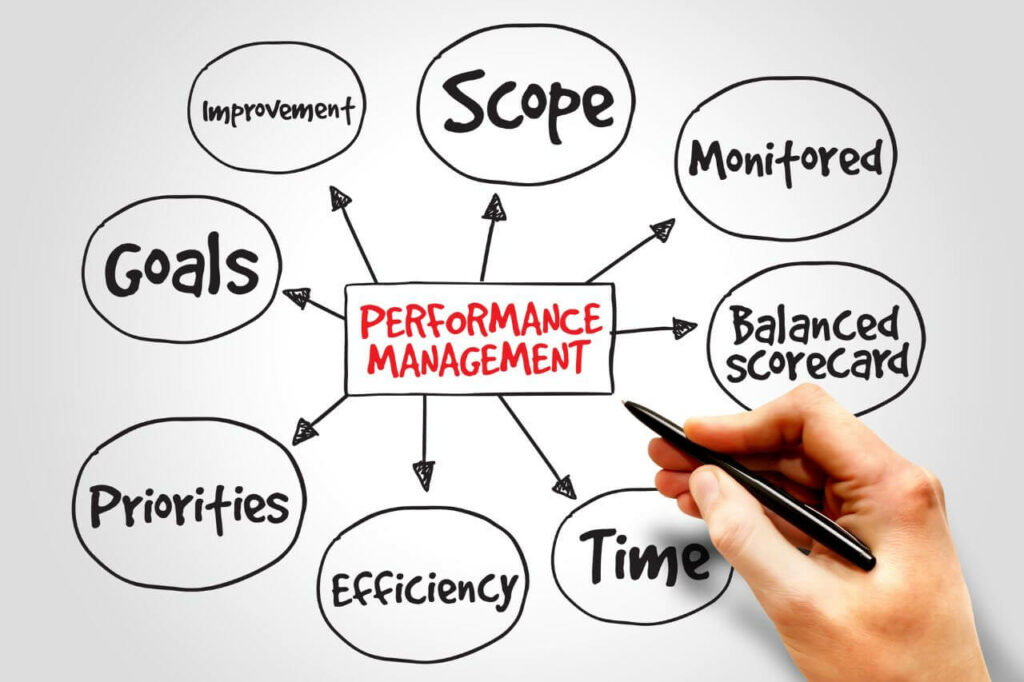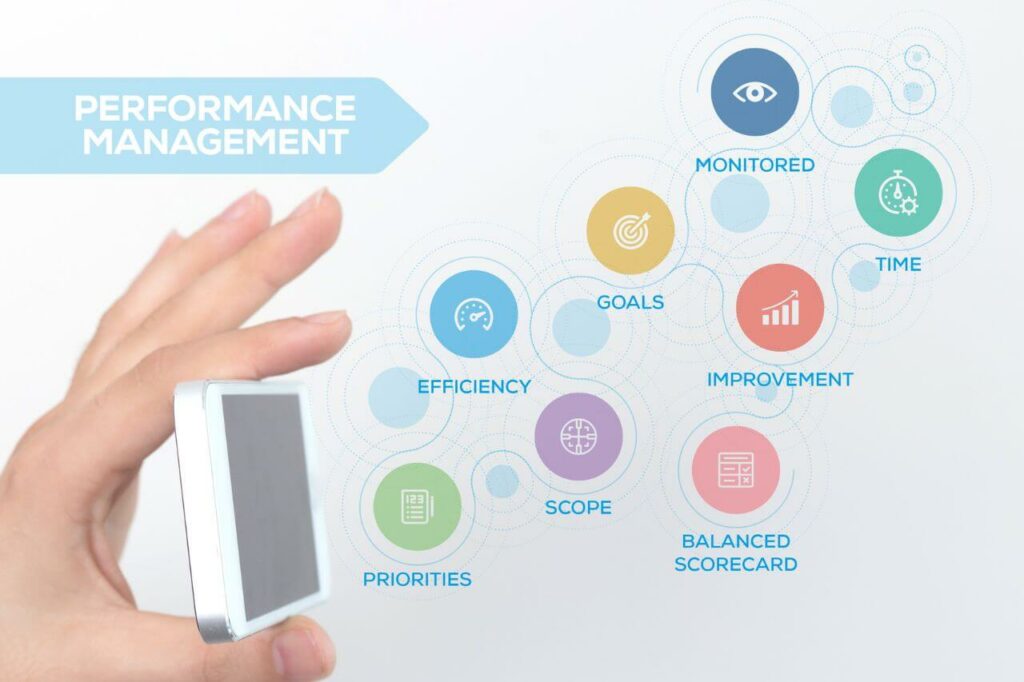In the wake of “the new normal”, many organizations seeking to increase competitive advantage and enterprise performance have resorted to various initiatives around process optimization, people, and performance management.
Now more than ever, organizations are coming to an acute awareness of the impact of people on corporate performance and business sustainability.
Hence, initiatives are in place to attract and manage the performance of people and upskill them to achieve organizational performance.
This post delves into the role of people as critical business assets, espouses the concept of Performance through People (PTP model), and finally discusses a robust and adaptive Agile performance management system.
People as a Business Asset
In business parlance, an asset is a resource of value owned by or leased to a business that helps run the business.
Assets could be tangible or intangible and have current and/or future economic value to the business.
As far as assets go, people (human resources) are the most important asset of the business. They’re critical success factors for the business and when managed properly, they can make a huge impact on profitability.
How exactly does this work?
- People are the major brand ambassadors of any business. They’re the face of the company to customers, and when managed and valued right, the bond is strengthened for every interaction with customers, leading to retention. Conversely, when they are not motivated, the lack of enthusiasm can rub off on the customers leading to churn.
- When people feel valued in the business and are managed right, it creates an enabling environment for innovation thus increasing the company’s competitive advantage.
- They could impact public perception of the brand whether client-facing or not.
- Valuing people is the best business model. According to an article by Forbes, companies that value their number one asset (employees) are more likely to succeed than those that do not. Statistics show that companies with a highly engaged workforce have 21% higher profitability and 17% higher productivity than companies with a disengaged workforce.
The question is how can companies achieve maximize productivity by leveraging their human resources.

The PTP model: Achieving Performance Through People
The Performance-Through-People strategy is a cutting-edge strategy that ensures that everyone in the organization at all levels understands clearly what’s expected of them and how best to achieve and align goals whether personal or organizational.
It’s a conscious set of processes focused on achieving financial success through loyal customers and motivated employees.
This is mainly because the biggest tool for generating superior customer service is the way a company trains and motivates even the lowliest of workers.
A research by Mckinsey clusters organizations into three broad groups:
- Performance-driven: Focus on top-tier financial results but not on capacity development or work environment
- People-focused: Focus on deploying resources towards developing employees but are unable to translate that into strong financials.
- People + Performance Winners: Creating opportunities for employees to build skills while consistently clearing the highest bar for financial performance.
The focus is not just on being a performance organization, but a people + performance winner.
The major difference between these two clusters is that while the former is focused solely on profitability and shareholder returns, P+P companies create opportunities for employees to build skills while keeping an eye on financial metrics.
P+P organizations also achieve 30% more revenue growth than either performance-driven or people-driven organizations.
These companies are consistent in achieving more consistent results and have greater earnings resilience, and they also have a superior ability to attract and retain talent- big wins in the volatile business climate.
To achieve a PTP model; the following are key ingredients:
- A leadership that motivates and inspires people
- Integration of customer and employee relationship management:
- A culture of feedback and alignment on expectations
- Training and capacity development
- Total rewards strategy
- Performance management framework

The Role of Performance Management
Performance Management essentially is the continuous process of improving performance by setting individual and team goals which are aligned with the strategic goals of the organization, reviewing and assessing progress, and developing the knowledge, skills, and abilities of people.
Performance management helps everyone in the organization at all levels see eye-to-eye and align goals and expectations.
When executed properly, it serves as a basis for employee capacity development, and career progression initiatives, and boosts employee productivity, engagement, and retention.
Since a good performance management framework has a clear line of sight between organizational objectives and individual performance indicators, it drives corporate performance.
Performance management is a cycle of activities around the pre-appraisal, appraisal, and post-appraisal stages.
1. Pre- Appraisal (The Planning Stage)
This stage typically involves agreeing on corporate objectives, cascading corporate objectives into departmental priorities, and cascading departmental priorities into SMART individual KPIs.
In this stage, individual KPIs are agreed on between the line manager and line report, a personal development plan and next steps are communicated and agreed upon, and where necessary, the job profile is reviewed or updated.
The core of this stage is alignment, to ensure that individual objectives align with the overall strategy of the organization.
2. Appraisal (Monitoring & Reviewing stage)
This is the stage where performance is usually delivered and results achieved. In this stage, managers give regular feedback to their team members and check in with them regularly.
They give effective feedback and coach line reports to overcome challenges or obstacles to performance improvement.
This then culminates in a review (or appraisal) of the employee’s performance relative to set objectives.
3. Post-Appraisal (Rewarding & Enhancing Stage)
In this stage, corrective, punitive, or rewarding measures are applied based on feedback from the appraisal process.
These could be rewards, recognitions, sanctions, or performance improvement plans. Feedback is gotten from managers and line reports and forms the basis for the planning stage of the next appraisal cycle.

Traditional Performance Management
Earlier, the world of business was characterized by a stable operating environment and towering pyramid hierarchy, tapering upward to top management.
It typically involves a set of activities that measures an employee’s performance over the year, on the basis of which an employee receives an appraisal letter; typically, by year-end.
The traditional performance management framework is usually characterized by the following:
- Top-down communication of expected performance standards
- Employees’ objectives are set early in the year and measured only during annual performance appraisals.
- Performance “shocks” for both employee and manager as appraisal and feedback aren’t continuous but limited to annual review sessions.
- Stiff and sometimes unhealthy competition (rather than collaboration) among employees since performance evaluation is closely tied to remuneration and career progression.
In light of the above, the aim of performing through people is somewhat defeated by the traditional performance management approach.

A Progressive Approach using Agile Performance Management
As aptly described in this research by Joanne Sammer, “90% of heads of Human Resource Departments believed their performance management system did not produce accurate information”, emphasizing the need for “rethinking stale performance management practices”.
Since the business environment is rapidly changing, previous performance criteria can quickly become stale or significantly inapplicable.
The “new normal” of work emphasizes the need for an open, inclusive, and frequent feedback system, centered around enhancing employee learning, productivity, and advancement.
It seeks to understand employees’ unique motivations, flexible goals to support the rapidly VUCA business environment, and a more collaborative feedback loop between employees and superiors which is in essence, an Agile Performance Management framework.
The big question, however, is how can Agile principles be applied to performance management and to what end.
Agile in its basal form comprises methodologies that are deployed under the following Agile Manifesto:
- Individuals and Interactions over processes and tools.
- Working software over comprehensive documentation.
- Customer collaboration over contract negotiation.
- Responding to change over following a plan.
Central to these principles is a degree of responsiveness to changing business realities and an emphasis on collaboration.
Agile operating models allow for quick and efficient reconfigurations of strategy, structure, processes, people, and technology toward value-creating and protecting opportunities, adding velocity and adaptability to stability, creating a critical source of competitive advantage in volatile, uncertain, complex, and ambiguous (VUCA) conditions.
Agile Performance Management is centered around:
Collaboration
Goals (team and individual) are linked to corporate priorities.
Since agile favors the concept of self-organizing teams, goals are set with a focus on team performance, teams are allowed to define and own their goals for ownership.
This in turn fosters collaboration rather than unhealthy competition.
Continuous Feedback
Rather than a routine end-of-year review, Agile performance management favors quarterly business reviews (QBRs), to ensure alignment, continuous feedback, and where necessary adapting priorities to current dynamic business realities.
Also, within teams, a culture of feedback via retrospection and introspection is regular. In fact, feedback structured and unstructured are the new normal.
Employees are encouraged to provide and accept feedback, creating a culture of courage and respect and Agile core values.
Continuous Improvement and Value Delivery
The focus of Agile performance management is on capacity development and empowering the team, through active coaching and stewardship.
Agile Performance management evaluates and manages the performance of individuals not just against hard targets but also by the extent to which the individual has shown and lived the desired values, mindsets, and behaviors, with a focus on value delivery.
Motivation & Sustainable Pace
Agile performance management fosters a work culture characterized by a sense of fulfillment and fun and promotes a sustainable pace of delivery; a balance between work and fun.
Conclusion
As more organizations recognize the complexity and volatility of the business environment, conscious efforts are needed to transition to Agile, even in performance management.
Agile performance management enhances a People + Performance environment critical for harnessing sustainability, profitability, and continuity.





